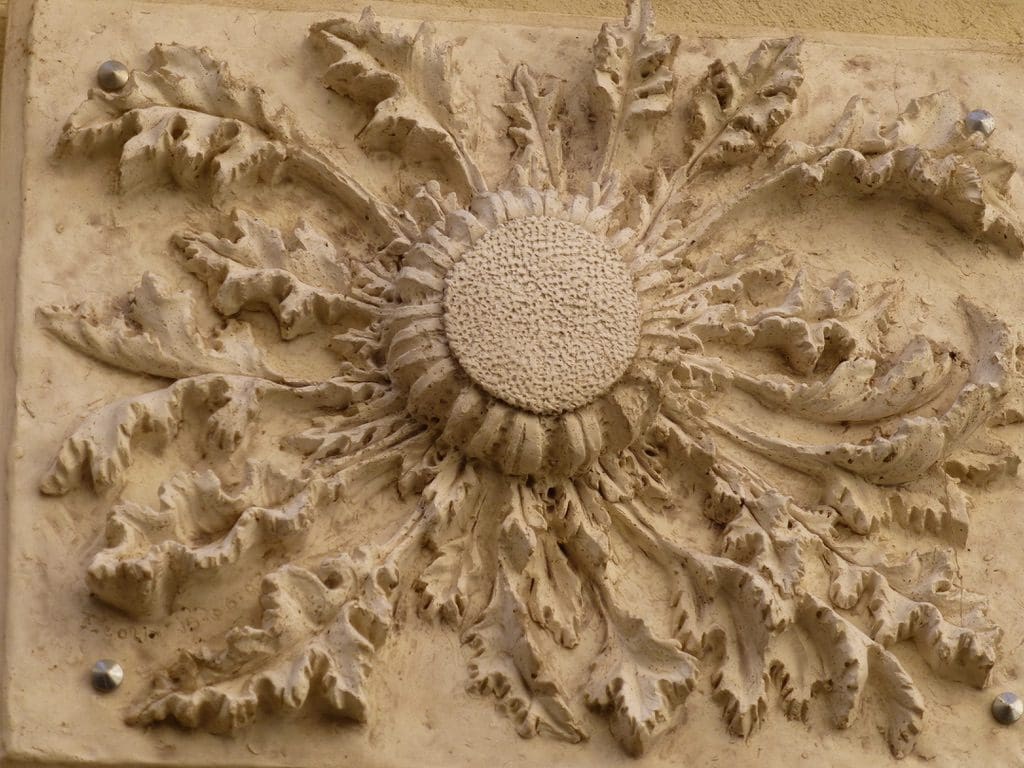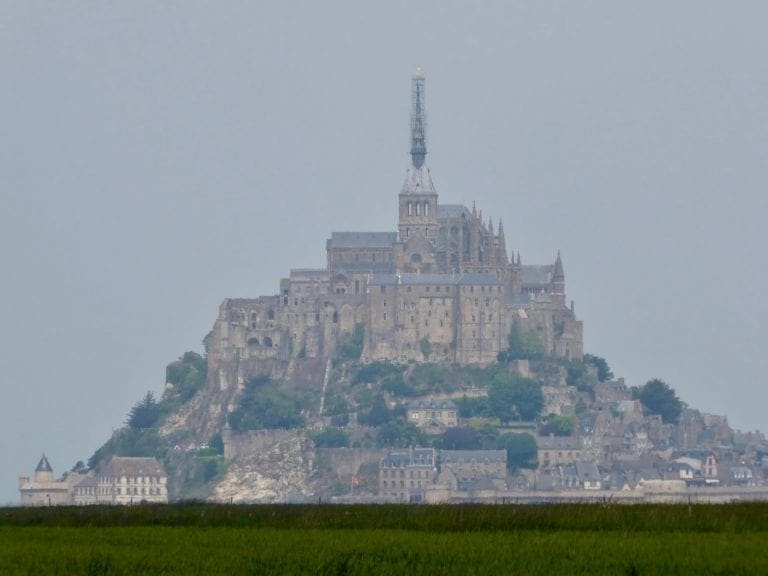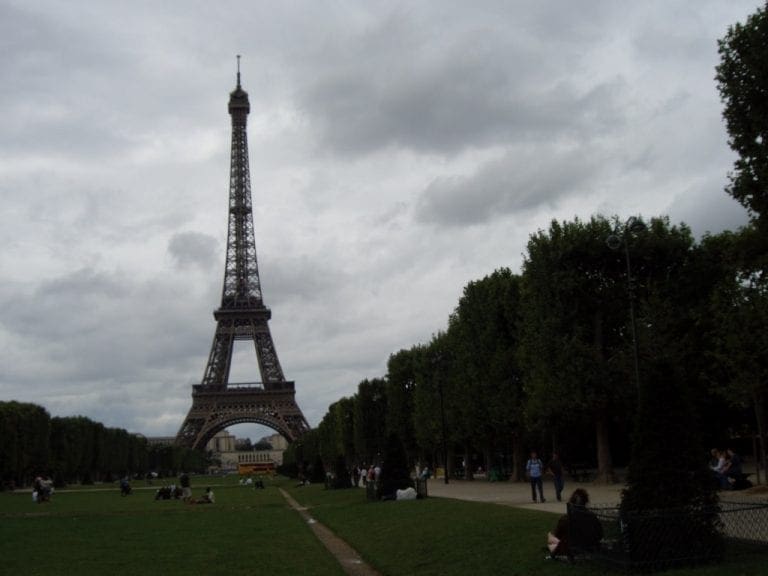France 2013 – week 7 – Montagnac 34530
16 Mar 2013. Saturday. Day 43. Change over day again. -5C overnight. Clear and sunny through to mid-afternoon – then snow! We packed up and cleared the house without problem. The house beside this one always has 2 cats asleep in a basket in the window in the sun. I’ve talked to the cats each time I passed – little knowing that I was easily seen through the lace curtain. This morning, madame came out to ask me to come in to see her five! cats. Two of hers and the rest rescues. Nice cats and nice lady. It would have been good to talk.
We headed off – first to Villefranche-de-Rouergue then Laguepie then Cordes-sur-Ciel then Albi. The country had significantly improved by Villefranche – rolling hills of very nice looking farm land – away from the depressing Lot valley. Laguepie was a delightful looking village. (It was a contender for one of the twelve cottages too. Ah Well.)
From there to Albi for lunch and the adventure began. I was aiming for the cathedral in the town centre – following signs to the Cathedral parking – but missed a turn, tried the next street – which was one way the wrong way by all the wide eyes cars coming towards me. Do a u-turn. Great, the next turn led to a car-park. Relief! We parked and began walking to the cathedral which surely could not be far? It was. After 400 metres, I remembered I had not locked the car. Trudged back to the car. Surely, it would be better to drive closer?
So, we paid for that lot of parking and drove towards the cathedral – and landed right into the midst of a market. Ah, an underground parking station, that will do! Wow, these underground parking spaces are very narrow. Can we get into one? There are none vacant. Down a level. Tried a couple of empty spaces – far too tight. The car might fit but no one could open the car doors. Let Helen out. Tried one next to a post where I could skew the car so I could get out and the driver next to me get in. Then, I almost could not get out of my door. Walked up the stairs and the door to the car park slammed and locked. How to get back in? A problem for later.
We were going to lunch at a place next to the cathedral where we had a good lunch in a very crowded restaurant in 2007. No crowd today. But very good food. La Tartine. A good lunch completed, we walked down the carpark ramp to the car. Now, how to get out of Albi. The girl went crazy. She had in mind us going down a road that was blocked ‘route barre’. No matter where I went, she turned us back to go along that street. I drove past the cathedral three times, found the Cathedral parking, did two illegal left turns (following a local). We eventually fooled the girl by plotting our own path and escaped Albi. The truly amazing thing is that we did all that without a fight – just laughter. I like Albi. But the roads are a nightmare.
From Albi we followed the N999 almost straight east along ridge tops for about 100km till near Millau we joined the motorway heading south. The weather closed in very rapidly and while we were going over the highest part (800m), it began to snow – sometimes quite heavily. I went as fast as I safely could along there just to get out of it. Very unpleasant. The snow was heaviest just before the descent. I think that with that amount of snow, the road would have only been open for another 30 minutes after we went through. No problem at all after we came down from the plateau.
Montagnac (our new home) is just 5 km off the motorway. The girl delivered us to the door. We could park at the front to unload before parking in the town car-park. These are very narrow streets!! The locals hurtle along them at alarming speeds. I had parked leaving just enough space for cars to squeeze past. One car went through without slowing at all. Scary! The next trick was to get from where we were to the village car-park. The gps went crazy again. We certainly went in a circle because we drove past our front door again. Parked, what a relief!
The house is amazing – one of my ‘three had to stay’ houses. This is a XV century merchant’s house. Beautifully restored – not over done. We have 3 floors but will probably use just to bottom two. Ground floor has kitchen and living area. First floor has our bedroom. With another bed-room above that. And laundry and terrace above that. I like this house very much.
17 Mar 2013. Sunday. Day 44. Half way, ie 43 days to go. A cloudy cold-ish day with a light wind to make it feel colder. We explored the town – which has an old fortified church as its centre and very narrow streets. A few tourist plaques to describe the village’s history. It all looks very ho ho yawn from the street, but these old walls hide some fascinating history. I especially liked the Rat family – tax farmers who owned most of one street. For lunch, pasties and rabbit stew from the local butcher. Excellent.
Began singing today. Very rusty after so many weeks off. Could only reach a D.
18 Mar 2013. Monday. Day 45. Very windy, sunny 14C. The usual morning walk to the baker – quite a line up. Montagnac is mostly closed on Mondays. Where we park is only free before 9am, between noon and 2pm and after 5pm. From what I can tell, parking is always free in France between noon and 2pm – who could be found to enforce parking at lunch-time. The sun prompted us to head to the coast. I wanted to go to Narbonne, so avoiding motorways, we drove through square kilometres of vineyards to Beziers. (This area of France is where most of the French table wine comes from.) Just south of Beziers, the road has many working girls in short skirts and high heels standing beside the road in a freezing wind. I had not seen that before. The Narbonne museum is closed on Mondays, so we drove back past all the working girls and went to Agde for lunch. Commercial Cafe – plat du jour €10.90 – entre plus main and 50ml of wine. We both had duck – little fillets lightly fried with potato chips. Desert was extra – €3.50 for a nice tarte cirton. Cafe Commercial was quite crowded in a little wind proof annex next to a flooding river very close to where the Canal du Midi comes in.

We then drove to the Cape of Agde where there is an enormous marina with very expensive looking boats. Found a beach with sand – with volcanic ash rock breccia making a cliff behind it – a nudist beach in summer – not today! Helen wanted to drive along the beach road. We kind of did that. The road marked on the map and that the girl wanted to take us along is now a bike track. Because they are trying to prevent the beach, road and railway being eaten by the sea, they have undertaken extensive beach stabilisation. We drove in confused circles through countless road works – twice, once in and once out.
Then we did find a good place to stop and look at the wind swept beach. As we were leaving, a young woman asked us a question and immediately switched to English – a young Parisian lawyer who had a few days at Montpellier. (In winter, Parisians wear a scarf curled several times around their neck. On holidays, they wear a nautical look – navy and white stripes. This lady had both.) We then drove back to Montagnac through a horrible traffic snarl around Sete. At Meze, the bay had oyster beds as far as the eye could see. Back at Montagnac, in our little road Rue de Commerce, there are a few posts carefully placed to stop parking on a tricky corner. One post can be removed to allow a single car to park – at its convenience.
19 Mar 2013. Tuesday. Day 46. Sunny 18C. My day was made by the wine at the end – a very good day all round. As we left the village, we called in at the friendly butcher and bought a picnic lunch. Terrine and local red wine with ‘bumph’. We went to St Guilhem le Desert. I am usually underwhelmed by these ‘must go to’ places. St Guilhem was different. Extremely good and well worth the trouble.
The 9th century church (what is left of it) is well worth the effort. I can see why it was a stepping off place for Compostella. We wandered around for a couple of hours down the one street town. Worth mention is the parking place 3 km out of town to cater for the bus loads of tourists who visit in the season – and shuttled into town. As we left, I called in at the TI Tourist Information Office. A beautiful 30 year old with good English told me of the wonders of the area – 3-4 languages, bored out of her very good mind.
Picnic lunch beside an abandoned barn beside an about to be abandoned vineyard. (We read that 40,000 ha of vineyard have been abandoned in the last five years.) We called in for a beer at Anine (in 728 it had 300 monks in opposition to St Guilhem). Then, we attempted a circuit drive up to a great lookout that we failed to reach. It was the narrowest winding road I have driven – no wider than the car. I bailed out when we found we were on the wrong road. Back to Montagnac by Motorway. Phew!
Then the good bit began. Our local fruit shop (100m away) sells bulk wine at €1.40 a kilo (note – not a litre – it was weighed and an estimate made for the weight of the container. I had heard that this was true and had to see if it was so.) We also bought cheese – I figured it had to be good or she would not stock it. It was excellent.
https://geoff.bellsite.id.au/2013/04/i-am-a-castle-chateau-church-village-in-southern-france.html
20 Mar 2013. Wednesday. Day 47. Sunny 18C. We chose to have lunch at Meze – a little sea-side village about 15 km south of us. An excellent day. We arrived at 11am and sat in the sun at the end of the marina watching people and boats and birds. At 12 noon, we began a cruise of the 10 restaurants around the head of the bay. We chose well – La Maison du Pecheur. We passed up the hot or cold oysters and went for a Bouillabaisse (fish soup) which was excellent – washed down with a local white. The soup defeated us.
We strolled again in the sun and on our way back to the car heard to unmistakable purtunk of a boules match. We had found the boule-adrome. What a close played match! Two teams of three players. Extremely skilled. One on each team was a ‘getter close’ to the couchonette. The other two were mainly bombers who could hit anything. The surface was so uneven that few boules were rolled along the ground – usually in a high drop shot. Very interesting.
We watched several ends. I think the major championship is tomorrow so the team was practicing. On our return to Montagnac, we spent the rest of the sunny afternoon on the top floor terrace. A very pleasant day doing nothing.

The kitchen/ground floor of our house looks onto a narrow street often with people walking by. There are a few cats – one of whom goes for a walk with the kids to school. Kids come back from school just after 5pm. We actually look out at a T-junction. If you take the left hand turn, you avoid the snarl of one way streets at the bottom. The left turn into the side street is extremely tight. One very narrow street turning into another very narrow street. It can be done in one pass even by trucks, but many take two or three backwards and forwards to get around. It is also interesting seeing cars get into and out of their garages onto this very narrow street. It takes 2-4 passes to get in or out. Back and forth. Good driving.
Singing. Got to an F# today. Just short of my top G.
21 Mar 2013. Thursday. Day 48. Sunny 17C. We visited three of the Templar/Hospitaller villages of Larzac near Millau. There are a string of these villages for which there is a circuit. The history is roughly like this. After the first Crusade, many pilgrims began to visit Jerusalem. In 1113, the Hospitallers began a set of places when pilgrims could seek shelter as they crossed the central massive. In 1118, the Templars did the same. For the next 200 years, these two groups were in opposition and both Templars and Hospitallers occupied the villages at various times. They were said to be good managers. Then in 1312, the Templars were declared heretics, they were burned and their property confiscated (transferred to the Hospitallers) – that sounds a bit political. The villages were essentially monasteries with good-ish agricultural land – bread, cheese and wine would have been the main crops. (Roquefort is just a few ks away.)
With the One Hundred Years war, the villages added walls (to keep out raiders – the walls would not have kept out an army). Ditto for the Wars of Religion when the area was captured by Huguenots. Quite a prosperous area. Now, they attract tourists – the latest form of pilgrim. Very little of the original buildings remains. Almost all the buildings in the villages are from XIV to XIX centuries. We visited three villages – La Cavalerie, Ste-Eulalie de Cernon (where we did an interesting full tour of the Cammandery which ‘commanded’ most of Larzac) and La Couvertoirade (very much set up for tourists with many boutiques and restaurants). The first two looked to be working villages, the third makes its living from tourists.
Got the G today. Singing going Ok with 4 weeks to the first concert.
22 Mar 2013. Friday. Day 49. Sunny early, then a drop of temp by noon. 14C. A day off. Helen obtained a nice paella for lunch from the local market.
We read that 1,000 people a month are migrating to this Department of Herault – in a way it is a bit like the Gold Coast of France – warmer and sunnier than the deep north. Many are retirees. That is a lot of new people to have to build infrastructure for. The small villages themselves, I would say, have lost their professionals – just as they have in Oz. Professionals move to the cities and bigger towns. Generally, the old historic part of the villages are restored as they were with their narrow streets and additional housing built on the outside. The size and amount of building outside the old village indicates the extent of local growth (or lack of it). Eg, Montagnac, La Cavalerie, Cahors, Montpellier, Meze, Sete, Sarlat have quite a lot of building outside the old village. La Couvertoirade has none – indicating that it is scratching along wholly dependant on tourism and very like a ski-hill that does not have any summer (in this case winter) trade. In a way, preserving all these old buildings is a curse as well as a blessing. A blessing because it gives a look at history. A curse because they are terribly difficult to keep warm in winter and cool in summer (very bad ‘environmental/insulation’ rating); the plumbing and electrical wiring will always be a problem. Parking in the narrow streeted towns is a genuine nightmare. (The real estate agents have to display the ‘energy rating’ of the building: new buildings with modern insulation get a green rating, these old houses get a strong red rating.) The local council issued a ‘look at what we’ve been doing for you’ brochure. Very informative for us. I wonder what the locals think about it. Into the bin as junk like we do in Sydney?
Local councils get to do very little in France – ditto for Departments and Regions. They get to ‘administer’. All government and decision making is done from Paris. Police, health, education, transport – everything is controlled from Paris.
Having said all that, the Montagnac ‘Stone House’ has been a delight. Extremely well located – 15 km from the sea-side and 5 knm from the motorway. Many things to see in the area. (As it is, we’ve seen fewer than half those I’d written down to visit.) A goodish supply of books to read (of which Helen has made good use). The house itself is very good to live it – even in winter. Such a good place. (34530 is the postcode. There are many Montagnacs in France.)




















